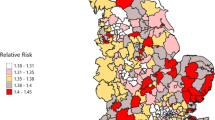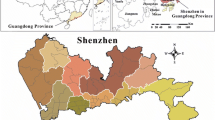Abstract
Introduction
The geographical distribution of mental health disorders is useful information for epidemiological research and health services planning.
Objective
To determine the existence of geographical hotspots with a high prevalence of schizophrenia in a mental health area in Spain.
Method
The study included 774 patients with schizophrenia who were users of the community mental health care service in the area of South Granada. Spatial analysis (Kernel estimation) and Bayesian relative risks were used to locate potential hotspots. Availability and accessibility were both rated in each zone and spatial algebra was applied to identify hotspots in a particular zone.
Results
The age-corrected prevalence rate of schizophrenia was 2.86 per 1,000 population in the South Granada area. Bayesian analysis showed a relative risk varying from 0.43 to 2.33. The area analysed had a non-uniform spatial distribution of schizophrenia, with one main hotspot (zone S2). This zone had poor accessibility to and availability of mental health services.
Conclusion
A municipality-based variation exists in the prevalence of schizophrenia and related disorders in the study area. Spatial analysis techniques are useful tools to analyse the heterogeneous distribution of a variable and to explain genetic/environmental factors in hotspots related with a lack of easy availability of and accessibility to adequate health care services.



Similar content being viewed by others
References
Anselin L (1995) Local indicators of spatial association: LISA. Geogr Anal 27(2):93–115
Arcury TA, Gesler WM, Presisser JS, Sherman J, Spencer J, Perin J (2005) The effects of geography and spatial behavior on health care utilization among the residents of a rural region. Health Serv Res 40(1):135–155
Assunção R, Costa M, Tavares A, Ferreira S (2006) Fast detection of arbitrarily shaped disease clusters. Stat Med 25:723–742
Bailey TC, Gatrell AC (1995) Interactive spatial data analysis. Longman Group Limited, Essex
Bamrah JS, Freeman HL, Goldberg DP (1991) Epidemiology of schizophrenia in Salford, 1974–84. Changes in an urban community over ten years. Br J Psychiat 159:802–810
Bernardinelli L, Pascutto D, Montomoli C, Wilks C (2000) Investigating the genetic association between diabetes and malaria: an application of Bayesian ecological regression models with errors in covariates. In: Elliot P, Wakefield J, Best NG, Briggs D (eds) Spatial epidemiology. Methods and applications. Oxford University Press, Oxford
Besag J, Newell J (1991) The detection of clusters in rare diseases. J R Stat Soc Ser A 154:143–155
Besag J, York J, Mollié A (1991) Bayesian image restoration with two applications in spatial statistics. Ann Inst Stat Math 43:1–21
Breslow N, Day N (1987) Statistical methods in cancer research, vol. 2: the design and analysis of cohort studies. International Agency of Research on Cancer, Lyon
Clayton DG, Kaldor J (1987) Empirical Bayes estimates of age-standardised relative risks for use in disease mapping. Biometrics 43:671–691
Cromwell J, Drozd EM, Gage B, Maier J, Richter E, Goldman HH (2005) Variation in patient routine costliness. J Ment Health Policy Econ 8:15–28
Edlund MJ, Belin TR, Tang L (2006) Geographic variation in alcohol, drug, and mental health services utilization: what are the sources of the variation? J Ment Health Policy Econ 9(3):123–132
Elliot P, Wakefield J, Best N, Briggs D (2000) Spatial epidemiology: methods and applications. Oxford University Press, Oxford
Garrido M, Salinas JA, Almenara J, Salvador L (2007) Atlas de salud mental de Andalucía 2005. Servicio Andaluz de Salud, Junta de Andalucía. Sevilla http://www.aan.org.es/Atlas_SM.pdf. Accessed 17 December 2007
Gelman S, Rubin D (1992) Inference from iterative simulation using multiple sequences (with discussion). Stat Sci 7:457–511
Giggs JA, Cooper JE (1987) Ecological structure and the distribution of schizophrenia and affective psychoses in Nottingham. Brit J Psychiat 151:627–633
Grubesic TH, Matisziw TC (2006) On the use of ZIP codes and ZIP code tabulation areas (ZCTAs) for the spatial analysis of epidemiological data. Int J Health Geogr 5:58
Gutierrez-Recacha P, Chisholm D, Haro JM, Salvador-Carulla L, Ayuso-Mateos JL (2006) Cost-effectiveness of different clinical interventions for reducing the burden of schizophrenia in Spain. Acta Psychiat Scand 111(Suppl 432):29–38
Hopper K, Wanderling J (2000) Revisiting the developd versus developing country distinction in course and outcome in schizophrenia: results from ISoS, the Who collaborative follow-up project. Schiz Bull 26:835–846
Kirkbride JB, Fearon P, Morgan C, Dazzan P, Morgan K, Murray RM, Jones PB (2007) Neighbourhood variation in the incidence of psychotic disorders in Southeast London. Soc Psychiatry Psychiatr Epidemiol 42:438–445
Lögdberg B, Nilsson LL, Levander MT, Levander S (2004) Schizophrenia, neighborhood, and crime. Acta Psychiat Scand 110:92–97
Lunn DJ, Thomas A, Best N, Spiegelhalter D (2000) WinBUGS—a Bayesian modelling framework: concepts, structure, and extensibility. Stat Comput 10:325–337
MacNab YC (2003) Hierarchical bayesian modeling of spatially correlated health service outcome and utilization rates. Biometrics 59:305–316
Maylath E, Seidel K, Werner B, Schlattamann P (1999) Geographical analysis of the risk of psychiatric hospitalization in Hamburg form 1988–1994. Eur Psychiat 8:414–425
McCreadie RG, Leese M, Tilak-Singh D, Loftus L, Macewan T, Thornicroft G (1997) Nithsdale, Nunhead and Norwood: similarities and differences in prevalence of schizophrenia and utilization of services in rural and urban areas. Br J Psychiatry 170:31–36
Moreno-Küstner B, Rosales Varo C, Torres González F (2002) The goals and method of the Andalusian Case Register for Schizophrenia. Int J Soc Psychiatry 48(1):47–54
Moreno B, Cervilla J, Luna J, Torres F (2007) Pattern of care of Schizophrenia patients in Granada. Int J Soc Psychiatry 53:5–11
Moscone F, Knapp M (2005) Exploring the spatial pattern of mental health expenditure. J Ment Health Policy Econ 8(4):205–217
Ord JK, Getis A (1995) Local spatial autocorrelation statistics: distributional issues and an application. Geogr Anal 27:286–306
Pérez-Naranjo LM, García-Alonso CR (2005) Spatial income distribution of horticultural farms in Andalusia. Cuadernos Geográficos 37:41–58
Rosenheck R, Astrachan B (1990) Regional variation in patterns of inpatient psychiatric care. Am J Psychiatry 147(9):1180–1183
Ruggeri M, Leese M, Thornicroft G, Bisoffi G, Tansella M (2000) Definition and prevalence of severe and persistent mental illness. Br J Psychiatry 177:149–155
Sabel C (1998) Peaks and troughs: space-time cluster detection in rare diseases. ESRI users conference. San Diego Convention Center 27–31 July 1998. http://gis.esri.com/library/userconf/proc98/PROCEED/TO250/PAP246/P246.HTM. Accessed 17 December 2007
Saha S, Chant D, Welham J, McGrath J (2005) A systematic review of the prevalence of schizophrenia. PLOS Med 2(5):413–433
Salvador-Carulla L, Tibaldi G, Johnson S, Scala E, Romero C, Munizza C, CSRP group, RIRAG group (2005) Patterns of mental health service utilisation in Italy and Spain—an investigation using the European Service Mapping Schedule. Soc Psychiatry Psychiatr Epidemiol 40(2):149–159
Salvador-Carulla L, Garrido M, McDaid D, Haro JM (2006) Financing mental health care in Spain: context and critical issues. Eur J Psychiatry 20(1):29–44
Scully PJ, Owens JM, Kinsella A, Waddington JL (2004) Schizophrenia, schizoaffective and bipolar disorder within an epidemiologically complete, homogeneous population in rural Ireland: small area variation in rate. Schizophr Res 67:143–155
Sheskin DJ (2000) Handbook of parametric and non-parametric statistical procedures. Chapman & Hall/CRC, Florida
Silverman BW (1986) Density estimation for statistics and data analysis. Chapman & Hall, London
Toral A (2001) Regional growth and convergence in the Spanish provinces. In: 41st congress of the European regional science association, Zagreb (Croatia)
Torrey EF, Mortensen PB, Pedersen CB, Wohlfahrt K, Melbye M (2001) Risk factors and confounders in the geographical clustering of schizophrenia. Schizophr Res 49:295–299
Vázquez-Polo FJ, Negrin MA, Salvador-Carulla L, Cabasés JM, Sanchez E (2007) Geographical differences in cost of schizophrenia in Spain: a Bayesian mapping approach. J Ment Health Policy Econ 10(Suppl 1):s44
Wakefield J, Elliott P (1999) Issues in the statistical analysis of small area health data. Stat Med 18(17–18):2377–2399
Williamson D, McLafferty S, Goldsmith V, Mollenkorpf J (1998) Smoothing crime incident data: new methods for determining the bandwidth in kernel estimation. http://gis.esri.com/library/userconf/proc98/proceed/to850/pap829/p829.htm. Accessed 17 December 2007
Youssef HA, Kinsella A, Waddington JL (1991) Evidence for geographical variations in the prevalence of schizophrenia in rural Ireland. Arch Gen Psychiatry 48:254–258
Youssef HA, Scully PJ, Kinsella A, Waddington JL (1999) Geographical variation in rate of schizophrenia in rural Ireland by place at birth vs place at onset. Schizophr Res 37:233–243
Zhu L, Gorman DM, Horel S (2006) Hierarchical Bayesian spatial models for alcohol availability, drug “hot-spots” and violent crime. Int J Health Geographics 2006, 5:54 http://www.ij-healthgeographics.com/content/5/1/54. Accessed 17 December 2007
Acknowledgments
This project was partly funded by the Andalusian Foundation for Social Integration of the Mentally ill Patients, the Spanish Ministry of Health (FIS: 98/087; redIAPP and SAMSERAP group:RD06/0018/0039) and the Andalusian Research Plan (PAI: CTS-01765 and CTS-587). We thank Francisco José Vázquez-Polo for his contribution to the Bayesian analysis and comments, also Carmen Rosales and José Alberto Salinas, geographers. We acknowledge all the staff of the South Granada Mental Health Area for help with data gathering. We would also like to thank Isolde Gornemann, Christina Emmett and Ian Johnstone for revision of the English text.
Author information
Authors and Affiliations
Corresponding author
Rights and permissions
About this article
Cite this article
Moreno, B., García-Alonso, C.R., Negrín Hernández, M.A. et al. Spatial analysis to identify hotspots of prevalence of schizophrenia. Soc Psychiat Epidemiol 43, 782–791 (2008). https://doi.org/10.1007/s00127-008-0368-3
Received:
Accepted:
Published:
Issue Date:
DOI: https://doi.org/10.1007/s00127-008-0368-3




